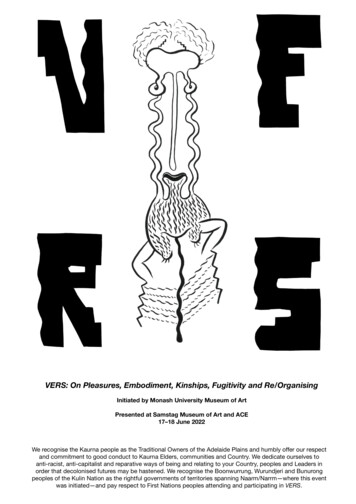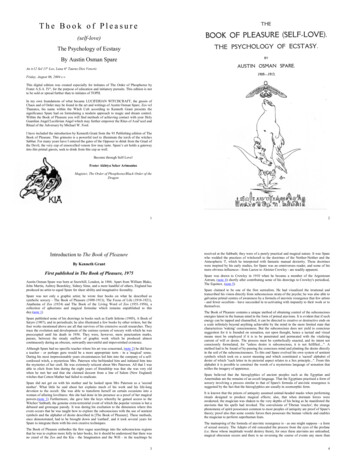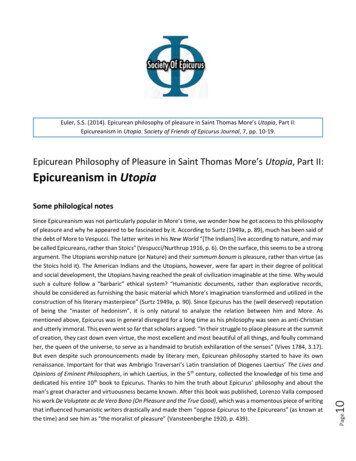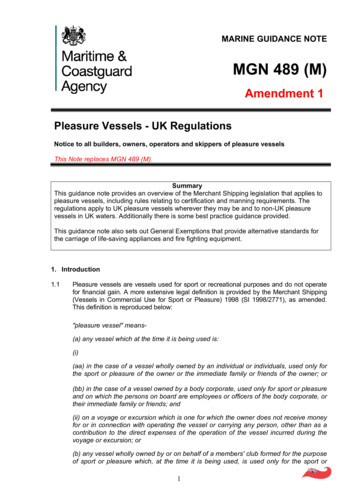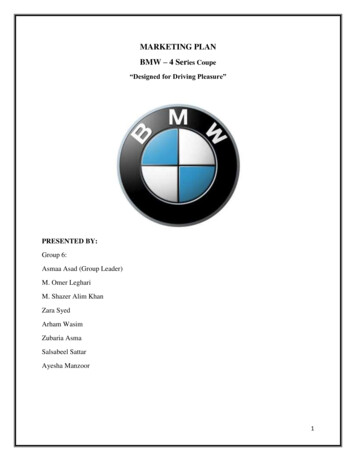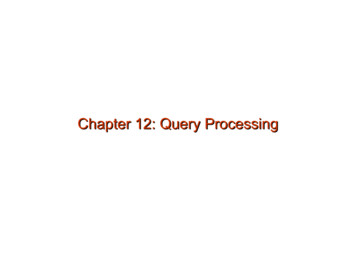
Transcription
ELECTRONIC JOURNAL FOR PHILOSOPHYISSN 1211-04426/2011University of EconomicsPraguee Relation between Quality of Pleasureand Quantity of Pleasure in J. S. Mill’sTheory of UtilitarianismPavel Janda
P. JandaRelation between Quality of Pleasure and Quantity of PleasureAbstractPresented paper critically explores Mill’s theory of quality of pleasure. J. S. Mill in hisattempt to secure utilitarian position against different adversaries introduced aconception of the quality of pleasure in order to reply to accusations thatutilitarianism ends up as a theory suitable only for animalistic part of human nature.Yet, his exposition of the aforementioned principle is far from being lucid. Especiallyhis theory of relation between quantity of pleasure and quality of pleasure suffersfrom many ambiguous or rather opaque parts. To explore these unclear thoughts isthe goal of this paper.AbstraktPráce si klade za cíl kriticky prozkoumat teorii J. S. Milla o rozlišení kvalitativní akvantitativní charakteristice požitků (pleasure). Mill svoji teorii představil jako reakcina kritiku, že utilitární teorie vyhovuje jen zvířecí povaze lidské přirozenost aneuvažuje o vyšších schopnostech lidského ducha. Millova expozice teorie ale nenív mnoha pasážích zcela jasná a průhledná. Práce se zaměřuje hlavně naprozkoumání problematického vztahu mezi kvantitativní stránkou a kvalitativnístránkou potěšení.Key wordsMill, quality of pleasure, quantity of pleasure, utilitarianismKlíčová slovaMill, utilitarismus, kvalita potěšení, kvantita potěšení2
P. JandaRelation between Quality of Pleasure and Quantity of PleasureIntroductionJ. S. Mill introduced in his work called “Utilitarianism” a conception of thecriterion of quality1 which may enable us to apprehend pleasure in a new way2.Purpose of this paper is to analyze Mill’s basic characteristics of the new criterionand point out main difficulties which, in my opinion, render the whole theoryuntenable. Although I agree with Mill’s main idea that it is necessary to sort outpleasures according to the qualitative aspect, I think that his elaboration of thisposition suffers from significant drawbacks. On grounds of my enquiryI will expose what kind of conditions Mill would have to accept to keep his theoryconsistent. Furthermore, I will show that if Mill accepted them, he would have todefend a theory which entails uncanny consequences. My enquiry will be based onanalysis of a statement which, in my opinion, constitutes the nucleus of the Mill’sapprehension of quality.“If one of the two [pleasures] is, by those who are competently acquainted with both, placedso far above the other that they prefer it even though knowing it to be attended with a greateramount of discontent, and would not resign it for any quantity of other pleasure which theirnature is capable of, we are justified in ascribing to the preferred enjoyment a superiority inquality, so far outweighing quantity as to render it, in comparison, of small account.”3The quoted passage provides us with four traits of the qualitative criterion.Firstly, it is said that we need somebody competently acquainted; so called anappropriate judge. Secondly, we know that qualitatively superior pleasure would bepreferred even if it were attended with a greater amount of discontent. Thirdly,qualitatively superior pleasure would not be resigned for any quantity of otherpleasure (I will call it as the criterion of resignation). Lastly, quality outweighsquantity so much as to render it of small account.In the rest of my paper, I will try to furnish evidence that these traits are notappropriate to guard Mill’s theory and their refusal or modification, with the attemptto preserve Mill’s theory as much as possible, leads to a specific apprehension of thequality of pleasure. I will not discuss the second trait because it would need anotherMill tries to show that we have another criterion to choose among pleasures than quantity ofpleasure: "It is quite compatible with the principle of utility to recognize the fact, that some kinds ofpleasure are more desirable and more valuable than others. It would be absurd that while, inestimating all other things, quality is considered as well as quantity, the estimation of pleasuresshould be supposed to depend on quantity alone." Mill, J. S. (1998), Utilitarianism, Oxford UniversityPress, Oxford, pp. 56.2 Let us remember that Mill bases utilitarianism on the Greatest Happiness Principle which: " holdsthat actions are right in proportion as they tend to promote happiness, wrong as they tend to producethereverseof happiness. By happiness is intended pleasure, and the absence of pain " Mill, J. S. (1998),Utilitarianism,pp. 55.3 Mill, J. S. (1998), Utilitarianism, pp. 57.13
P. JandaRelation between Quality of Pleasure and Quantity of Pleasureprofound consideration, which would extend this paper too far from its original ideaand herewith this trait has, from all aforementioned traits, strictly speaking, the leastconnection with my main topic (relation of quantity of pleasure and quality ofpleasure). My main thesis is, as has been already stated in a more general way, thatby holding Mill’s theory we (or Mill himself) would have to accept certain andspecific understanding of quality of pleasure, which is not conclusive and, as Ibelieve, even plausible.Convertibility of PleasureLet us first consider the fourth trait which adverts to relation between qualityof pleasure and quantity of pleasure. Mill’s distinction of quality and quantity inpleasure has to be based on one crucial supposition, which Mill does not, however,explicitly mention. He must not admit any possible measurability (reducibility)between quality of pleasure and quantity of pleasure. If there was any plausibility tofind out or estimate a ratio between quality and quantity we could, then, draw atransfer table. In other words, we could express quality in quantitative terms andwhole distinction would loose its effect because quality would be only differentlyexpressed quantity. Even if Mill does not make a direct reference to this condition hetries to secure it in a few ways. That Mill cannot allow the quality of pleasure to beexpressible in the terms of the quantity of pleasure will serve us as a starting point.This aim will consequently lead me firstly to examine the relation between quality ofpleasure and quantity of pleasure and later on between quantity of thing whichproduces any pleasure and quality of pleasure. Let us now closely approach aproblematic situation which is caused by possible reducibility of quality of pleasureinto quantity of pleasure.I believe that it is vital to avoid convertibility between quality of pleasure andquantity of pleasure because if such a situation happened, all Mill’s effort would benugatory4. In other words, for example let us suppose reading a book producescertain amount of quantity of pleasure and certain quality of pleasure. If we had apossibility to express quality of pleasure in the terms of the quantity of pleasure, wecould, then, prefer one thing to other because of quantity of pleasure it causes. Itmeans that we prefer reading book because of quantity of pleasure it produces. Then,Mill’s aim is to avoid an accusation that:" Now, such a theory of life excites in many minds andamong them in some of the most estimable in feeling and purpose, inveterate dislike. To suppose thatlife has (as they express it) no higher end than pleasure- no better and nobler object of desire andpursuit- they designate as utterly mean and grovelling; as a doctrine worthy only of swine " Toavoid such conclusion and to confirm that: "Human beings have faculties more elevated than theanimal appetites, and when once made conscious of them, do not regard anything as happiness whichdoes not include their gratification " Therefore, if we accept the reducibility of quality of pleasureinto quantity we risk that utilitarianism could be again accused of being the theory suitable for swine.Mill tends to base utilitarian defense on the firm ground. Mill, J. S. (1998), Utilitarianism, pp. 55-56.44
P. JandaRelation between Quality of Pleasure and Quantity of PleasureMill has to face a very disturbing situation. If things produce quality of pleasure andquantity of pleasure and quality of pleasure is expressible in (can be reduced into)the terms of the quantity of pleasure, we can order these things according to thequantity of pleasure they produce.We could ask, what does it mean that quality of pleasure renders quantity ofpleasure of small account? In the situation when there is a possibility of conversion ofquality of pleasure into quantity of pleasure, it means that by converting even smalllevel or amount of quality of pleasure into quantity of pleasure we gain a greatamount of quantity of pleasure. If it is so, then e. g. reading a book (considered ashaving high quality of pleasure) if expressed only in quantity of pleasure wouldproduce much higher quantity of pleasure then for example drinking alcoholicbeverages (considered as having low quality of pleasure).If we follow aforementioned course, then everybody, who maximise pleasureincluding those who consider only quantity of pleasure, have to choose the samething (in our example reading a book) because it produces higher of pleasure. It canbe said because it produces higher quantity of pleasure since we can transfer qualityof pleasure into quantity of pleasure. In other words, everybody will prefer reading abook to drinking alcoholic beverages and if not he is not maximizing his pleasure.We face here two difficulties. Firstly, this conclusion contradicts our experience.Secondly, choosing only according to quantity of pleasure should be according toMill avoided. Therefore if we enable any possible conversion we face a situationwhich provides results which does not agree with reality and an issue which shouldbe avoided. Therefore we have to enquire, by which manners Mill tries to avoidpossible conversion of the quality of pleasure into the quantity of pleasure. Mill’sidea that quality renders quantity as unimportant may be significant in consideringthe certain relation between quantity and quality but it is not very helpful to avertthe danger of possible conversion of quality into quantity – I think it has only adissuasive influence. And this danger must be averted in the first place if we want sosave Mill’s theory.When Mill proclaims that quality surpasses quantity in such a way as to render itof small account, it seems that this statement does exactly the opposite of what it issupposed to accomplish. In stead of building an impenetrable barrier betweenquantity and quality of pleasure, it places them into a relation. Yet, Mill’s argumentaims at something rather different. If we accept that enjoyment is superior in qualitywhen it outweighs quantity as to render it of small account, there is no need toproceed with mutual comparison of quality and quantity.The fact is that in this case Mill only dissuades from exploring precise ratiobetween quality and quantity by revealing the partial answer. On the other hand,Mill’s argumentation indicates that the relation between quantity and quality may5
P. JandaRelation between Quality of Pleasure and Quantity of Pleasureexist. It seems that quality and quantity are in some kind of proportional relationbecause quality renders quantity as unimportant. The question is whether therelation between quantity of pleasure and quality of pleasure allows us to find aparticular example with a turning point where additionally increased quantity ofpleasure could surpass quality of pleasure5. Possibly then, we could find otherinstances and their turning points that would enable us to construct an approximateconversion table between quality of pleasure and quantity of pleasure. That is exactlythe situation which endangers Mill’s theory. If somebody argued that by adding thequantity of pleasure the quality of pleasure would also rise (or change in anydirection) we would reach the answer. We would have the measure whereby wecould translate quality of pleasure into quantity of pleasure. In other words, noquality change could be correlated to quantity change. If we, ceteris paribus, addquantity of pleasure, quality of pleasure can not change. If it does, then, there is adiscernible relation and possibility of conversion of quality into quantity6.5Let us consider two lower pleasures (we know that one pleasure is preferable), both withquantitative and qualitative aspect. To mention the most obvious example we will assume that thepleasure A is preferable and in comparison to pleasure B pleasure A provides less quantitative andmore qualitative pleasure. Than we can, as first and rather intuitive method, add quantitative partsuntil we will able to surpass the A pleasure by B pleasure. This is possible but doesn’t give directlyclear result considering amount of quantitative pleasure which had to be added (the relationshipbetween quantity and quality). The second course supposes to process more abstractly but with muchovert result. Let us imagine that we manage to subtract from both pleasures (A and B) thatquantitative part which is smaller. Now on one side we have only qualitative aspect and on the otherquantitative and qualitative aspect. Let us suppose that A (which lost its all quantitative aspect) is stillpreferable to B. Then we will add to B always the same part (we create unite of measure – we add thequantity which remained after subtraction). In this way how many units have to be added to surpassthe A pleasure by B pleasure.I will show what I mean by using a more concrete example. The following example is meant mostlyas an illustrative one and very probably contains many simplifications. Let us accept that we candistinguish between quality of pleasure and quantity of pleasure. Let us further accept that we canexpress the magnitude of both pleasures (understood as mathematical quantities) and that thequantities of the same kind may be added together. Then, if one thing produces a total pleasure whichis for this particular instance defined as a combination of quality of pleasure (QlP) and quantity ofpleasure(QnP)wecanwriteTP xQlP yQnP, where x and y are numbers expressing height, level or anything expressing themagnitude of the quality and quantity of pleasure. Then, we could find two things which produce thesame total pleasure TP1 TP2. It means that xQlP yQnP cQlP zQnP which leads to QlP QnP (zy)/(x-c). Here we have a precise ratio between quality of pleasure and quantity of pleasure and wecan express quality of pleasure in the terms of quantity of pleasure. 6 We can write this equation forany two pleasures with equal total pleasure. If there is a general determinate relationship betweenquality of pleasure and quantity of pleasure (e.g. if quantity of pleasure rises then quality of pleasurerises by certain amount) then we will always reach the same result expressing the relation betweenquality of pleasure and quantity of pleasure. In other words, the fraction (x-c)/(z-y) or (z-y)/(x-c) willalways bring the same result for all instances and will enable us to determine the precise relation. Yet,if there is no correlation between quantity of pleasure and quality of pleasure we will not be able todetermine a general result applicable for all instances. Still, no correlation between quality of pleasure66
P. JandaRelation between Quality of Pleasure and Quantity of PleasureResignation of Pleasure - InterpretationDisproportion between quantity and quality of pleasure seem to be alsosecured by the third trait which treats the possibility/impossibility of resignation7 ofone pleasure for another. According to Mill’s definition the pleasure superior inquality would be never resigned for any quantity of other pleasure. It seems that Milldenies any possibility of surpassing quality by quantity after all. I will try to provethat Mill’s definition cannot be used as a general rule because we can find a case inwhich it leads to a contradiction.It is important to enquire what Mill really means by his criterion of resignation ofpleasure8. We know that it is supposed to help us to determine which pleasure isqualitatively higher. Every decision of the height of the quality of pleasure can beexpressed (reduced) by means of the comparison of two pleasures: we compare if wewould resign one particular pleasure for any quantity of other particular pleasure. Itis natural that we do not know which pleasure is qualitatively higher, if we knew thetest would be futile. The test may proceed subsequently. We compare one pleasurewith the maximum quantity of other pleasure. If we decide that we would not resignthe first one for the maximum quantity of the other it could be entailed that the firstone is qualitatively higher than the second one because if it is not resigned for themaximum quantity we would not resign it for any quantity.and quantity of pleasure is only one of necessary conditions which prevent a possible conversion ofquality of pleasure into quantity of pleasure.7 I find that the criterion of the resignation of pleasure is very significant. Even if it would be meantas a mere figure of speech it is still a part of the most important sentence which defines the quality ofpleasure. Moreover, I believe that it is more coherent to enquire Mill’s own words and endogenouspart of Mill’s theory than trying to implement some exogenous assumption. Even if we accept thecriterion of appropriate judges, we have to determine the nature of experience meant by Mill.Otherwise we fall into a vicious circle: some pleasure is higher because appropriate judges say so andwho does not agree is not an appropriate judge etc. From this point of view, I believe that criterion ofthe resignation of pleasure may be used as an appropriate criterion of judge’s experience and itsadvantage is that, as said, it is endogenous to the Mill’s theory. From these reasons I believe that thefollowing enquiry is appropriate. Then, according to this criterion experienced judge went through somany comparisons between pleasures that he can determine which one he would never resign for anyquantity of other pleasure.8Let us properly define used terminology. By the term “any quantity” I will understand thehighest possible quantity of pleasure. Hereby if we refuse to resign qualitatively superior pleasure forthe maximum quantity of other pleasure, then we would refuse it for any quantity lower thanmaximum. By the term “other pleasure” I understand any kind of pleasure which is conceived asqualitatively inferior. The general assumption is that we want to maximize our pleasure.7
P. JandaRelation between Quality of Pleasure and Quantity of PleasureFor examined case, the maximum quantity of pleasure may be understood asmaximum number of things or as maximum pleasure they may cause. In the firstexample it is possible to understand it as maximum of things which I can consumeeven if my pleasure from consuming is diminishing. But such position cannot beaccepted since we maximize our pleasure. In the second case to consume themaximum means to reach a level of satisfaction when another unit consumedproduces marginal utility equaled to 0 or negative. This approach is acceptablebecause we seek and reach the maximum pleasure. Therefore we have to ask if weare willing to resign pleasure A for, in the second way defined, any maximumquantity of pleasure of B. This approach has an advantage that if we determine thatwe would not resign pleasure A for maximum quantity of pleasure B than we wouldnot resign it for any other quantity of pleasure B. Vice versa, if we resign pleasure Afor some, lower than maximum, quantity of pleasure from B then, we wouldcertainly resign it for maximum quantity of pleasure from B.It would be more accurate to say that by not resigning one pleasure for anyquantity of other pleasure we only keep the possibility that scrutinized pleasure isthe higher one (qualitatively) but such a comparison does not prove that onepleasure is qualitatively higher than the other one. It is truth and it will be examinedand proved that we need to add another criterion to decide about qualitative relationbetween two pleasures. Yet, in practice it is impossible to compare all the pleasurestogether and reach an absolute knowledge and therefore, for everyday life, we needan operative criterion. Secondly, if we do not accept the criterion of resignation ascriterion which decides between two particular pleasures but as a criterion assigningpleasure to two different and absolute categories (lower and higher pleasures) wewill reach another type of decision based on quantity of pleasure, however, this timebased on the two-level schema. In other words, the decision would be based purelyon the quantity of pleasure only applied on two different levels of pleasures9.I will explain the difference. If we accept an operative criterion we will gain,maybe, an infinite series of pleasure ranked according to the height of quality. In thisordered series the law of transitivity must be valid. It may seem that in this mannerwe postulate that the most supreme pleasure (concerning quality) exists. Yet, this istrue only if we understand our series as static one (taken in one moment and nochanges permitted). If we accept it as the dynamic structure there will not be (even ifit cannot be fully precluded) any firmly rooted supreme pleasure. By dynamicstructure I mean changes which may affect our perception of pleasure (e. g. newinformation about its effects) or appearing of new pleasures. In this model situationwe may choose among pleasures according to their quality. On the contrary, if weaccept the absolute interpretation we will be able to determine two levels of9I will call it as an absolute interpretation of the criterion.8
P. JandaRelation between Quality of Pleasure and Quantity of Pleasurepleasures differentiated by their level of quality. Yet inside these two levels we willnot be able to follow any qualitative distinction and we will have to find anothercriterion which will enable us to choose among different pleasures. I tend to thinkthat in order not to add something new into the theory this measure would be basedon the quantity of pleasure. This will be more deeply enquired in the followingsections.Then, if we find that we would never resign some pleasure (pleasure A) for anyquantity of other pleasure (pleasure B) we have a reasonable believe that the firstpleasure may be qualitatively higher than the second one. In this comparison, wehave three possible outcomes. The first possibility is that we are right and pleasure Ais really qualitatively higher than pleasure B. Other two possibilities are that bothpleasures are either qualitatively higher or qualitatively lower. If one of these twopossibilities occurs we would have to find another criterion which would decideamong pleasures on both levels. If we are unable to distinguish among them andtherefore choose, we may end like “Buridan’s ass”. Because we maximize ourpleasure and the quality cannot be used as differentiating principle we can use as aprinciple either quantity of pleasure or we can correlate a quality to some magnitude(e. g. number of things consumed) and suppose that we may somehow amplify thequality of pleasure by consuming more and more things. This amplifying of qualitywould not mean changes in the level of quality (we would be still on the one of twolevels lower/higher) but rather it would amplify the quality of pleasure inside theappropriate level (I would call it the quantity of quality). Yet, I do not know and seeany way which would allow such procedure, which, I believe, seems ratherimplausible.However, in both cases we are dealing with direct or indirect quantity of pleasureand we fall back to the situation in which we choose according to the quantity ofpleasure. We should remember that in the realm of Mill’s theory we try to avoid suchsituation. It can be avoided, as said, if we accept that the criterion of resignation is adeterminant criterion between two particular pleasures and if we want to determinewhich one is (at least more possibly) qualitatively higher only relatively to each other– for practical use (it means only with certain probability). In this way we can reallychoose according to quality of pleasure and not according to quantity of pleasureonly in two different levels. It seems that this interpretation is also in accordancewith the beginning of the cited sentence which stands as a base for my enquirybecause it starts with: “Of two pleasures 10”10Mill, J. S. (1998), Utilitarianism, pp. 56.9
P. JandaRelation between Quality of Pleasure and Quantity of PleasureResignation of Pleasure - ApplicationTherefore I prefer to examine the criterion of resignation as the criterion ofdecision about qualitative relation between two pleasures than as criterion ofassignment of pleasures into two levels of quality. To compare both pleasures weneed a common denominator otherwise we could compare incomparable. Here weface a problematic situation. On the one side of comparison we have maximumquantity of pleasure but on the other side we have only further unspecified“pleasure”, which may be at most assumed as qualitatively higher. Yet, still itsqualitative position may be only assumed and as such can not be used asdeterminant in the comparison. Moreover, if we compared directly two qualities ofpleasure we would not need any quantity of pleasure. Yet, we do not knowqualitative positions (if the quality is high or low and how high or how low) ofcompared pleasures. In accordance with Mill we will accept maximum quantity ofpleasure as one side of the comparison.We have three possibilities to fill the other side in comparison. It can be quantityof pleasure, quality of pleasure and quality of pleasure and quantity of pleasuretogether. Second and third possibility suffers from two vital drawbacks. Firstly, assaid, we do not know the quality of pleasure. And, secondly, even if we knew it, sucha comparison with quantity of pleasure, which we accepted as one part of thecomparison, would call, in accordance with the requirement of the principle ofcommon denominator, to translate quality of pleasure into quantity of pleasure. Ashave been shown in the previous paragraphs of my work, to avoid the possibility ofconversion of the quality of pleasure into quantity of pleasure is vital condition forwhole theory. Then, only possibility we are left with, is to put on the other side ofcomparison the quantity of pleasure. However, this possibility, as will be shown,leads to contradictory results.I will simulate a very simple model situation11. I will use basic economical terms tosimplify the example and to show that my thoughts are expressible in generallyaccepted terms. As have been shown we have to supply both sides of comparisonwith the quantity of pleasure. As a quantity of pleasure I will use concepts ofmarginal utility (MU) and total utility (TU). Let us have two pleasures: consumingapples and drinking scotch. Using this example, I will examine whether it is possibleto determine the qualitative superiority according to the aforesaid principle. Firstconsumed apple brings to the consumer MUa1 6 utility and marginal utility of anyother unit is MUan 1/2*MUan-1 where n 1,.,4 and “n” indicates the number ofconsumed apples and “a” is a symbol for “an apple”. If MUa1 6 then MUa2 3 and soDitto, this example is rather a simple one (it is based on simple suppositions like additivity ofpleasure and reducibility of pleasure into numeric expression tec. Yet, it provides an insight in theargumentation. In such case its simplicity should not be seen as inadequate. It shows that we are ableto build up even very simple model, which contradicts Mill’s conclusion.1110
P. JandaRelation between Quality of Pleasure and Quantity of Pleasureon. First scotch brings MUs1 9 and any other MUsn 1/3*MUsn-1 where n 1, ,4 and“n” indicates the number of consumed glasses of scotch and “s” is a symbol for“scotch”. Let us, for simplicity, suppose that only four units of one article or bothtogether can be consumed before marginal utility becomes negative. We can, then,count the maximum total utility which can be reached by consuming scotch, which is13 and 1/3 and the maximum total utility which can be reached by consumingapples, which is 7 and 9/12.Generally, it seems probable that considered pleasure can be in one comparisonhigher and in another one lower. It means that e. g. reading a detective novel isqualitatively higher than drinking alcoholic beverages but it is qualitatively lowerthan reading Byron’s poetry. In other words, a series of pleasures is createdaccording to their quality. Yet, it would be rather strange if in the one comparison thepleasure would be once higher and once lower, depending on question we ask. Thisis the case of given example. Generally speaking, in such instances it does matter ifwe ask “Would we resign A for the maximum quantity of pleasure B?” or “Wouldwe resign B for a maximum quantity of pleasure of A?” because the answer dependson the order of asked questions. Let us have a look at the concrete example.Would we be prompted to resign all scotch to have 4 apples which maximize ourtotal utility? We would not because by combining two apples and two glasses ofscotch we can reach TU 21, which is grater than TU 7 and 9/12. Since we would notresign pleasure of drinking scotch for any quantity of pleasure from eating apples itentails that pleasure from drinking scotch is qualitatively superior to pleasure fromeating apples. Now, would we resign pleasure from eating apples for 4 glasses ofscotch which maximize our total utility? Again, we would not because combiningthis time e. g. one apple and three glasses of scotch brings TU 19, which is graterthan TU 13 and 1/3. Because we would not resign pleasure of eating apples f
pleasure: "It is quite compatible with the principle of utility to recognize the fact, that some kinds of pleasure are more desirable and more valuable than others. It would be absurd that while, in estimating all other things, quality is considered as well as quantity, the estimation of pleasures should be supposed to depend on quantity alone

